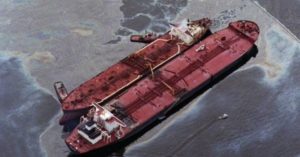 Thirty years ago, this Sunday, at just after midnight on March 24, 1989, the Exxon Valdez supertanker ran aground in Prince William Sound off the south coast of Alaska. No-one was hurt, but the ship’s hull was ruptured, and of the 1.26m barrels of crude on board about 258,000 spilled into the water. The National Transportation Safety Board inquiry found that the causes of the accident included the failure of the ship’s master to provide a proper navigation watch “because of impairment from alcohol”, as well as inadequate personnel training and deficient management oversight.
Thirty years ago, this Sunday, at just after midnight on March 24, 1989, the Exxon Valdez supertanker ran aground in Prince William Sound off the south coast of Alaska. No-one was hurt, but the ship’s hull was ruptured, and of the 1.26m barrels of crude on board about 258,000 spilled into the water. The National Transportation Safety Board inquiry found that the causes of the accident included the failure of the ship’s master to provide a proper navigation watch “because of impairment from alcohol”, as well as inadequate personnel training and deficient management oversight.
Even decades after the spill, there was still evidence of the oil visible on some of the beaches in the region. Exxon agreed to pay $900m for restoration to settle damages claims from the state and federal governments, and the work of the Exxon Valdez Oil Spill Trustee Council, which oversees the use of that money, goes on. The Pacific herring population in Prince William Sound has collapsed since the early 1990s, although it is not clear whether the spill was responsible.
For the oil industry, the disaster was transformative. Single-hulled tankers began to be phased out, to be replaced by safer double hulls, first in the US and then worldwide. The process was accelerated after the sinking of the tanker Erika off the coast of Brittany in 1999, an accident that was considered one of France’s worst environmental disasters.
In 1989, oil companies and other businesses and organisations set up the Global Climate Coalition, which argued that the cause of the global warming since the 19th century was “an open question”, and suggested that most, if not all of it was “part of a natural warming trend”. Thirty years later, US politics is still characterised by deep disagreements not just over climate policy, but over the fundamental science.
The looming deadline of January 1 next year for ships to cut their sulphur emissions to comply with International Maritime Organization rules is one of the biggest regulatory changes to hit the oil market for years.
Source: “The Week in Energy: The Exxon Valdez Spill 30 Years on”, Financial Times
